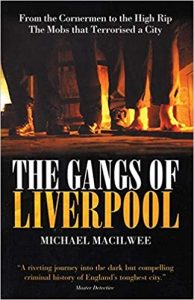Sadly not a British indie version of Scorsese’s grand piece, Gangs of New York (though this book does reference the other), Gangs of Liverpool is the 2006 book by Michael Macilwee that looks into the slums of late 19th Century Liverpool to reveal the criminal gangs that ‘terrorized’ the city. Although this is mostly a great social history of the time, it also gives a fascinating glimpse into the way the landscape of Liverpool has changed in the intervening century.
The majority of the ‘action’ takes place in the north of Liverpool, and the opening chapter relates the events of the ‘Tithebarn Street outrage’ – the murder of Richard Morgan in August 1874. This is spark that ignites an explosion of violent attacks over the next 20 or so years. The book then takes us through the development of more organised gang activity – from the informal gathering of ‘Cornermen’ to the infamous ‘High Rip’ gang whose notoriety spread to the national press.
Darkest North Liverpool
As this very website itself hopes to show, at the end of the 19th Century the Tithebarn Street / Scotland Road area consisted of a mass of courts, narrow streets, dark alleys, and a pub on every corner. The photographs which dot the book, especially the generous number in the first two chapters, show how the main streets looked much more like Paradise Street or Castle Street, compared to the large office buildings which dominate today.
Another thing revealed in the landscape, and one which the Liverpudlians of the time were often only too aware, was the concentration of certain nationalities and religions in different areas. As might be expected, the Scotland Road area was often known as the Scotland Quarter, but it was the Irish community, many employed on ships or in the docks, that suffered much from sectarian violence.
The Catholic community concentrated in the north of the area, while the Protestants (and Orangemen) were more likely to be found further south. This often led to conflict, with and without provocation, and at one point Macilwee relates the startling vision of 200 Irish navvies marching down the Leeds Liverpool Canal in the direction of Bootle village, with the intention of causing trouble with the Orangemen in Scotland Road. Just over 30 brave police constables managed to turn them around, but as they were being escorted back north, the numbers increased to around 1000. You’ll have to get your own copy to find out what happened next…
The Victorian landscape of Liverpool
However, as with any study of the urban landscape, it’s tempting to overstate the influence the physical city has on society. Many streets of course had members of both Protestant and Catholic congregations, and indeed the two intermarried. But the book sheds very interesting light on how the Victorian city looked, as well as the wider politics of defining the gangs, and the reactions of a police force often unable to properly deal with the problem.
The book is scholarly, well-written with an eye for tense narrative. It reveals an often neglected contributor to Liverpool’s reputation for lawlessness and violence, including a great glossary of ‘Underworld Slang’, which I’m certainly going to make use of in everyday life. I’d certainly recommend it for anyone looking for an engaging peek into a violent past, and a bit of an eye opener for those who think the kids are getting worse.
Now, me donah’s grabbed the rasher wagon, so I’m off for a tightener…
Buy the book
Although it’s getting hard to get hold of, you can buy the book, usually for £7.99, from Hive (affiliate link), which helps support independent bookshops near you.
You can also find out more from the publisher, Milo Books (Web Archive).

